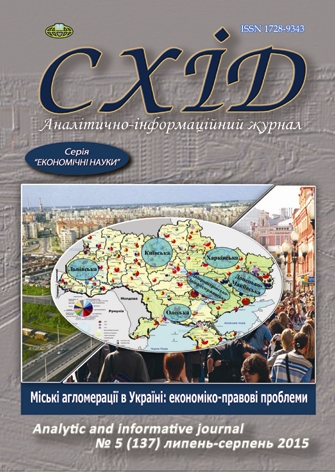Analysis of foreign experience of development management of urban agglomerations
DOI:
https://doi.org/10.21847/1728-9343.2015.5(137).51071Keywords:
urban agglomerations, foreign experience, development, managementAbstract
Article is devoted to the foreign experience of development management of urban agglomerations. The work is characterized European and world agglomerations as major centers that are able to accumulate the economic potential of countries and increase their competitiveness. The differences in the development of urban agglomerations in the world and in Ukraine are determined by different vision of the main components of the system management of urban agglomerations. The management systems agglomerations in foreign countries are classified. The main four management models agglomerations abroad are identified. There are agglomeration in the form of public formation with one level of local government; agglomeration in the form of public formation "second tier" with preservation of the existing local government; "fragmented" or contracted agglomeration; agglomeration governed by regional authorities. Their negative and positive sides are revealed. The examples of European and international experience in regulating the development of agglomerations. On the basis of the identified features of models management of urban agglomerations abroad proposals for the construction of a national system of management of urban agglomerations are substantiated. It is concluded that the formation of Ukrainian management model agglomerations should be based on the implementation of the policy of a common organizational thinking, voluntary and parity of the parties involved in the process, diversity of forms of their interaction.
Downloads
References
SaliiI.M. (2005), Urbanization inUkraine: social and managerial aspects, Naukova dymka, Kyiv, 304 p. (ukr).
Verlanov Yu.Yu., Verlanov O. Yu. (2010), Agglomeration in Ukraineand economic growth, Scientific papers of Petro Mohyla Black Sea State University. Series Economics, Vol. 133, issue 120, pp. 116-124 (ukr).
Hladkyi O. V.(2014), The formation and development of the Kyiv industrial agglomeration in market conditions, Kyiv geographical Yearbook, issue 9, pp. 90-109 (ukr).
Tyshchenko O. P., Prosianuk N. V (2013), Resource potential of urban agglomerations: problems of effective management, Ekonomichnyi chasopys-ХXІ, 9/10 (2), pp. 3-6 (ukr).
Sluka N.A. (2005), Urban centric model of the world economy,Moscow, 167 p. (rus).
Blasio G., Addario S. Di (2005), Do Workers Benefit From Industrial Agglomeration?, Journal of Regional Science, 4, Vol. 45, pp. 797-827 (engl). doi: 10.1111/j.0022-4146.2005.00393.x
Ottaviano G., Puga D. (1997), Agglomeration in the global economy: a survey of the "new economic geography". CEPR, Discussion Paper, № 356, 33 p. (engl).
Territorial Development inUkraine: development of agglomerations and subregions (2012), U.S. Agency for International Development (USAID) under the "Local Investment and National Competitiveness", Kyiv, 183 р. (ukr).
Osypov V. M., Kukosh M. S. (2014), The competitiveness of urban agglomerations: global trends and prospects formation in Ukraine, Economic innovation, 57, pp. 283-296 (ukr).
Hot spots: Benchmarking global city competitiveness: analytic report, available at: http:// www.citigroup.com/citi/citiforcities/pdfs/eiu_hotspots_2012. pdf (engl).
Mironov N. M. (2009), Urban agglomerations: foreign experience, Mestnoye pravo, 5-6, pp. 53-80 (rus).
Shevileva E. E. (2012), The system of regulation of agglomeration: Russiaand Western Europe, Problems of the modern economy, 2 (42), pp. 364-367 (rus).
Orlova Ye. (2012), "When 1 + 1 = 3", available at: http://city-manager.org (rus).
Downloads
Published
How to Cite
Issue
Section
License
Copyright (c) 2015 Nataliya Chuvikina

This work is licensed under a Creative Commons Attribution-NonCommercial-NoDerivatives 4.0 International License.
1. Authors bear responsibility for the accuracy of facts, quotations, numbers and names used.
2. Manuscripts are not sent back.
3. The publisher does not always agree with the authors' opinion.
4. The authors reserve the right to authorship of the work and pass the first publication right of this work to the journal under the terms of a Creative Commons Attribution-NonCommercial-NoDerivatives 4.0 International License. This license allows others to distribute (copy) the published work for non-commercial purposes, provided there is mandatory attribution to its authors and a link to the first publication in our journal.
5. The authors have the right to conclude separate supplement agreements that relate to non-exclusive work distribution in the form in which it has been published by the journal (for example, to upload the work to the online storage of the journal or publish it as part of a monograph), provided that the reference to the first publication of the work in this journal is included.

